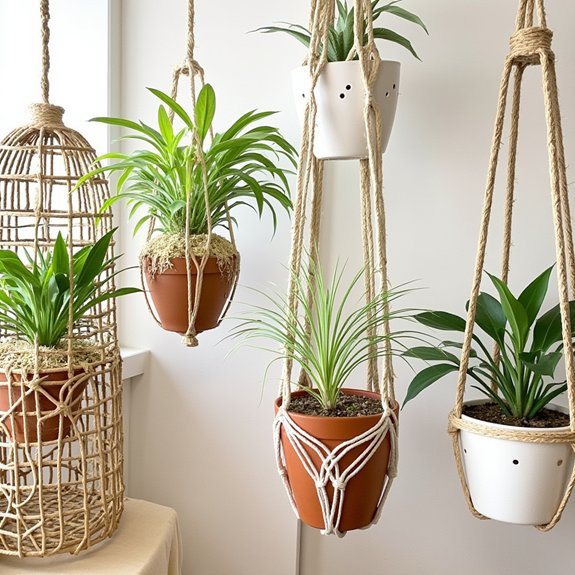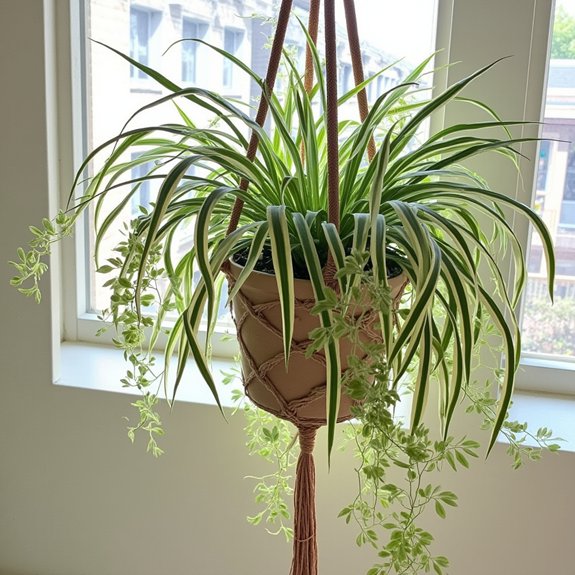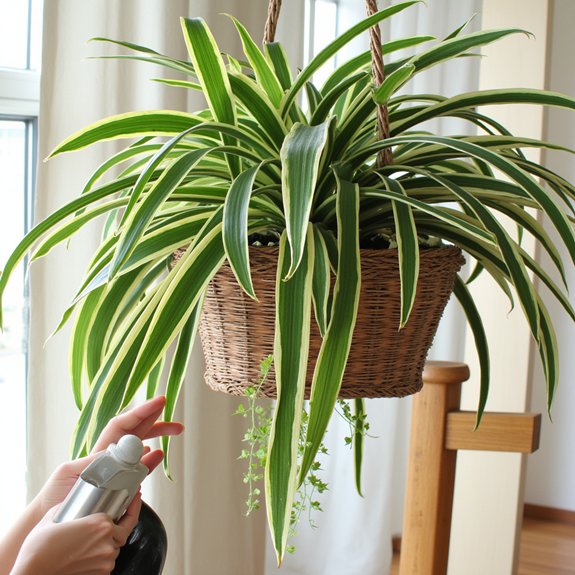Spider plants dangle gracefully from hanging baskets, creating cascading displays that transform any space into a green sanctuary. These resilient houseplants seem deceptively simple to grow, yet many enthusiasts struggle with drooping leaves, stunted growth, or failing plantlets. The secret lies in understanding their specific needs, from container selection to precise watering schedules. Most people make critical mistakes in the first few weeks that determine whether their spider plant will flourish or merely survive.
Contents
- 1 Selecting the Perfect Basket and Container
- 2 Creating the Ideal Soil Mix and Watering Strategy
- 3 Optimal Lighting and Placement Guidelines
- 4 Proper Fertilization Techniques
- 5 Essential Maintenance and Watering Practices
- 6 Understanding When and How to Repot
- 7 Spider Plant Characteristics and Growth Patterns
- 8 Long-term Care for Thriving Hanging Spider Plants
Selecting the Perfect Basket and Container

Most gardeners underestimate how essential container selection becomes for spider plant success, yet this single decision affects everything from plant health to visual appeal. Choose smaller baskets that leave only two inches around the edges, preventing your plant from looking lost while encouraging that stunning cascading effect.
Basket materials matter greatly for hanging applications. Lightweight plastic containers offer durability and easy handling, while wire baskets with coconut coir provide visual appeal but create indoor mess. Avoid heavy ceramics or terra cotta that strain hanging hardware. Container sizes should accommodate confined root growth, as spider plants actually thrive in snug spaces rather than oversized pots.
Creating the Ideal Soil Mix and Watering Strategy
Spider plants demand airy, well-draining soil that prevents the deadly trap of root rot, making standard potting soil far too heavy for their delicate root systems. The ideal soil composition combines two parts potting soil, one part perlite, and one part coconut coir for optimal drainage.
Monitoring moisture levels requires checking soil dryness between waterings, as spider plants prefer slight dehydration over soggy conditions. Overwatering kills more plants than drought ever could.
Remove hanging baskets for proper watering sessions, allowing excess water to drain completely in sinks before rehanging to prevent floor puddles and root damage.
Optimal Lighting and Placement Guidelines

Perfect drainage means nothing if light exposure sabotage growth from the start. Spider plants thrive in bright, indirect sunlight, avoiding direct rays that scorch delicate foliage. Position hanging baskets near windows with filtered light, ensuring consistent illumination without harsh afternoon sun.
Optimal height balances accessibility with lighting needs. Hang baskets where morning or east-facing light reaches easily, typically 3-4 feet from windows. Avoid placing them too high, which limits light access and complicates watering routines.
Rotate baskets weekly for even growth, preventing lopsided development. Close windows during strong drafts, maintaining stable environmental conditions for healthier plants.
Proper Fertilization Techniques
Balanced nutrition transforms ordinary spider plants into lush, cascading masterpieces that flourish year-round. Understanding nutrient requirements guarantees robust growth without damaging delicate root systems. Water-soluble fertilizer types work best, delivering consistent nutrition during active growing seasons.
Apply balanced fertilizer every four to six weeks from spring through early fall. A 10-10-10 or 20-20-20 formula provides essential nitrogen, phosphorus, and potassium. Dilute to half-strength to prevent root burn, as spider plants prefer gentle feeding over aggressive nutrition.
Winter months require complete fertilization cessation. Dormant plants cannot process nutrients effectively, making excess fertilizer harmful rather than helpful for long-term plant health.
Essential Maintenance and Watering Practices

Two critical practices determine whether hanging spider plants thrive or merely survive in indoor environments. First, remove the basket for watering sessions to prevent messy spills and guarantee proper drainage. Spider plants prefer drying out slightly between waterings, so check soil moisture regularly rather than following rigid schedules. Watering frequency depends on humidity levels, light exposure, and seasonal changes.
Second, monitor the plant’s response to environmental conditions. High humidity levels reduce watering needs, while dry indoor air increases them. During winter months, reduce watering as growth slows. Always water thoroughly in a sink, allowing excess water to drain completely before rehanging the basket.
Understanding When and How to Repot
Although spider plants tolerate being slightly rootbound, they eventually outgrow their containers and signal the need for fresh soil and more space. Key repotting signs include roots circling the pot’s bottom, emerging from drainage holes, or pushing soil upward. Quick-growing specimens may need annual attention, while typical plants require repotting every two to three years.
Effective repotting techniques involve gently removing the plant, dividing overcrowded root systems, and using fresh, well-draining soil mix. Choose containers only slightly larger than the previous pot to maintain proper moisture levels and prevent overwhelming the root system with excess space.
Spider Plant Characteristics and Growth Patterns
Graceful cascades of green and cream-striped foliage make spider plants instantly recognizable among houseplant enthusiasts. These hardy perennials showcase distinctive growth habits, sending out long, arching stems called stolons that produce plantlets or “spiderettes.” Mature plants can reach 12-24 inches in width, creating dramatic spillover effects in hanging baskets.
Leaf variations include solid green varieties and the popular ‘Variegatum’ with cream-colored stripes. Spider plants grow quickly during spring and summer, often doubling in size within months. Their resilient nature allows them to withstand occasional neglect while maintaining attractive appearance, making them perfect cascading specimens for indoor display.
Long-term Care for Thriving Hanging Spider Plants
While spider plants demonstrate remarkable resilience during their initial months, establishing a consistent long-term care routine guarantees decades of healthy growth and continuous plantlet production. Regular repotting every two to three years prevents root-bound conditions, with quick growers requiring annual attention. The plant benefits from balanced fertilization during spring and summer months, followed by winter dormancy periods.
Propagation techniques become essential for managing mature plants, as dividing overcrowded specimens maintains basket weight limits while creating new specimens. Monitor plantlet development closely, removing babies when roots reach one inch long. Consistent watering schedules, quarterly fertilization, and annual soil rejuvenation guarantee peak performance throughout the plant’s extended lifespan.
